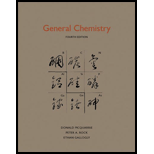
Concept explainers
a)
Interpretation:
Balanced chemical equation for the reaction of silver nitrate with sodium sulfate has to be determined.
Concept Introduction:
The reaction that has equal number of atoms of different elements in reactant as well as in product side is called balanced
a)
Explanation of Solution
The steps to balance a chemical reaction are as follows:
Step 1: Write the unbalanced equation.
Step 2:Then write the number of atoms of all elements that are present in chemical reaction in the reactant side and product side.
i) On reactant side,
Number of silver atom is 1.
Number of nitrogen atom is 1.
Number of oxygen atoms is 7.
Number of sodium atom is 2.
Number of sulfur atoms is 1.
ii) On product side,
Number of silver atom is 2.
Number of nitrogen atom is 1.
Number of oxygen atoms is 7.
Number of sodium atom is 1.
Number of sulfur atoms is 1.
Step 3: Balance the number of other atoms of elements except, oxygen by multiplying with some number on any side. First, balance the number of silver atom and sodium atom. Multiply
Step 4: After this, balance the number of oxygen atoms. The oxygen atoms are balanced on both sides. Now the reaction is,
Step 5:Finally, check the number of atoms of each element on both sides. If the number is same then chemical equation is balanced. The balanced chemical equation is,
b)
Interpretation:
Mass of
Concept Introduction:
Mole is S.I. unit. The number of moles is calculated as ratio of mass of compound to molar mass of compound.
Molar mass is sum of the total mass in grams of all atoms that make up mole of particular molecule that is mass of 1 mole of compound. The S.I unit is
The expression to relate number of moles, mass and molar mass of compound is as follows:
Mass percent is calculated by the mass of the element divided by the mass of compound and multiplied by 100.
The formula to calculate mass percentage of substance is as follows:
For more than one quantity of reactants in a reaction, the reactant that is completely consumed and controls the amount of product synthesized is called limiting reactant. The other reactants are called excess reactants. Also, the limiting reactant is completely consumed the initial mass of limiting reactant is used to calculate mass of product.
b)
Answer to Problem 11.55P
Mass of)
Explanation of Solution
The reaction is as follows:
The formula to calculate moles of
Substitute
The formula to calculate moles of
Substitute
To find the limiting reactant, divide the number of moles of each reactant by their stoichiometric coefficients.
i) The stoichiometric coefficient of
ii)The stoichiometric coefficient of
The number of moles of
The reaction is as follows:
According to stoichiometry of reaction, 2 moles of
The formula to calculate number of moles of
Substitute
The formula to calculate mass of
Substitute
c)
Interpretation:
Excess reactant has to be determined. Mass of excess reactant after completion of reaction has to be determined.
Concept Introduction:
Refer to part (b).
c)
Answer to Problem 11.55P
Mass of excess
Explanation of Solution
The number of moles of
According to stoichiometry of reaction, 2 moles of
The formula to calculate number of moles of
Substitute
Excess mole of
Substitute,
The formula to calculate mass of
Substitute
Want to see more full solutions like this?
Chapter 11 Solutions
General Chemistry
- Hi, I need your help with the drawing, please. I have attached the question along with my lab instructions. Please use the reaction from the lab only, as we are not allowed to use outside sources. Thank you!arrow_forwardHi, I need your help i dont know which one to draw please. I’ve attached the question along with my lab instructions. Please use the reaction from the lab only, as we are not allowed to use outside sources. Thank you!arrow_forward5. Write the formation reaction of the following complex compounds from the following reactants: 6. AgNO₃ + K₂CrO₂ + NH₄OH → 7. HgNO₃ + excess KI → 8. Al(NO₃)₃ + excess NaOH →arrow_forward
- Indicate whether the product formed in the reaction exhibits tautomerism. If so, draw the structure of the tautomers. CO₂C2H5 + CH3-NH-NH,arrow_forwardDraw the major product of this reaction N-(cyclohex-1-en-1-yl)-1-(pyrrolidino) reacts with CH2=CHCHO, heat, H3O+arrow_forwardDraw the starting material that would be needed to make this product through an intramolecular Dieckmann reactionarrow_forward
- Draw the major product of this reaction. Nitropropane reacts + pent-3-en-2-one reacts with NaOCH2CH3, CH3CHOHarrow_forwardIndicate whether the product formed in the reaction exhibits tautomerism. If so, draw the structure of the tautomers. OC2H5 + CoHs-NH-NH,arrow_forwardExplain how substitutions at the 5-position of barbituric acid increase the compound's lipophilicity.arrow_forward
- Explain how substitutions at the 5-position of phenobarbital increase the compound's lipophilicity.arrow_forwardName an interesting derivative of barbituric acid, describing its structure.arrow_forwardBriefly describe the synthesis mechanism of barbituric acid from the condensation of urea with a β-diketone.arrow_forward
 ChemistryChemistryISBN:9781305957404Author:Steven S. Zumdahl, Susan A. Zumdahl, Donald J. DeCostePublisher:Cengage Learning
ChemistryChemistryISBN:9781305957404Author:Steven S. Zumdahl, Susan A. Zumdahl, Donald J. DeCostePublisher:Cengage Learning ChemistryChemistryISBN:9781259911156Author:Raymond Chang Dr., Jason Overby ProfessorPublisher:McGraw-Hill Education
ChemistryChemistryISBN:9781259911156Author:Raymond Chang Dr., Jason Overby ProfessorPublisher:McGraw-Hill Education Principles of Instrumental AnalysisChemistryISBN:9781305577213Author:Douglas A. Skoog, F. James Holler, Stanley R. CrouchPublisher:Cengage Learning
Principles of Instrumental AnalysisChemistryISBN:9781305577213Author:Douglas A. Skoog, F. James Holler, Stanley R. CrouchPublisher:Cengage Learning Organic ChemistryChemistryISBN:9780078021558Author:Janice Gorzynski Smith Dr.Publisher:McGraw-Hill Education
Organic ChemistryChemistryISBN:9780078021558Author:Janice Gorzynski Smith Dr.Publisher:McGraw-Hill Education Chemistry: Principles and ReactionsChemistryISBN:9781305079373Author:William L. Masterton, Cecile N. HurleyPublisher:Cengage Learning
Chemistry: Principles and ReactionsChemistryISBN:9781305079373Author:William L. Masterton, Cecile N. HurleyPublisher:Cengage Learning Elementary Principles of Chemical Processes, Bind...ChemistryISBN:9781118431221Author:Richard M. Felder, Ronald W. Rousseau, Lisa G. BullardPublisher:WILEY
Elementary Principles of Chemical Processes, Bind...ChemistryISBN:9781118431221Author:Richard M. Felder, Ronald W. Rousseau, Lisa G. BullardPublisher:WILEY





